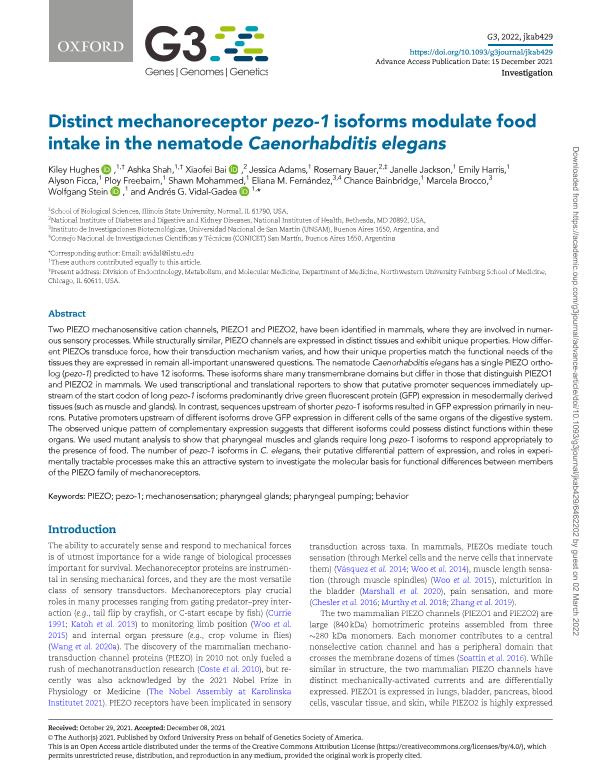Artículo
Distinct mechanoreceptor pezo-1 isoforms modulate food intake in the nematode Caenorhabditis elegans
Hughes, Kiley; Shah, Ashka; Bai, Xiaofei; Adams, Jessica; Bauer, Rosemary; Jackson, Janelle; Harris, Emily; Ficca, Alyson; Freebairn, Ploy; Mohammed, Shawn; Fernandez, Eliana Mailen ; Bainbridge, Chance; Brocco, Marcela Adriana
; Bainbridge, Chance; Brocco, Marcela Adriana ; Stein, Wolfgang; Vidal Gadea, Andrés G.
; Stein, Wolfgang; Vidal Gadea, Andrés G.
 ; Bainbridge, Chance; Brocco, Marcela Adriana
; Bainbridge, Chance; Brocco, Marcela Adriana ; Stein, Wolfgang; Vidal Gadea, Andrés G.
; Stein, Wolfgang; Vidal Gadea, Andrés G.
Fecha de publicación:
12/2021
Editorial:
Genetics Society of America
Revista:
G3: Genes, Genomes, Genetics
e-ISSN:
2160-1836
Idioma:
Inglés
Tipo de recurso:
Artículo publicado
Clasificación temática:
Resumen
Two PIEZO mechanosensitive cation channels, PIEZO1 and PIEZO2, have been identified in mammals, where they are involved in numerous sensory processes. While structurally similar, PIEZO channels are expressed in distinct tissues and exhibit unique properties. How different PIEZOs transduce force, how their transduction mechanism varies, and how their unique properties match the functional needs of the tissues they are expressed in remain all-important unanswered questions. The nematode Caenorhabditis elegans has a single PIEZO ortholog (pezo-1) predicted to have 12 isoforms. These isoforms share many transmembrane domains but differ in those that distinguish PIEZO1 and PIEZO2 in mammals. We used transcriptional and translational reporters to show that putative promoter sequences immediately upstream of the start codon of long pezo-1 isoforms predominantly drive green fluorescent protein (GFP) expression in mesodermally derived tissues (such as muscle and glands). In contrast, sequences upstream of shorter pezo-1 isoforms resulted in GFP expression primarily in neurons. Putative promoters upstream of different isoforms drove GFP expression in different cells of the same organs of the digestive system. The observed unique pattern of complementary expression suggests that different isoforms could possess distinct functions within these organs. We used mutant analysis to show that pharyngeal muscles and glands require long pezo-1 isoforms to respond appropriately to the presence of food. The number of pezo-1 isoforms in C. elegans, their putative differential pattern of expression, and roles in experimentally tractable processes make this an attractive system to investigate the molecular basis for functional differences between members of the PIEZO family of mechanoreceptors.
Palabras clave:
BEHAVIOR
,
MECHANOSENSATION
,
PEZO-1
,
PHARYNGEAL GLANDS
,
PHARYNGEAL PUMPING
,
PIEZO
Archivos asociados
Licencia
Identificadores
Colecciones
Articulos (IIBIO)
Articulos de INSTITUTO DE INVESTIGACIONES BIOTECNOLOGICAS
Articulos de INSTITUTO DE INVESTIGACIONES BIOTECNOLOGICAS
Citación
Hughes, Kiley; Shah, Ashka; Bai, Xiaofei; Adams, Jessica; Bauer, Rosemary; et al.; Distinct mechanoreceptor pezo-1 isoforms modulate food intake in the nematode Caenorhabditis elegans; Genetics Society of America; G3: Genes, Genomes, Genetics; 12; 3; 12-2021; 1-13
Compartir
Altmétricas



